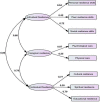Resilience to COVID-19 challenges: Lessons for school psychologists serving school-attending black South African youth aged 10 to 19 years old
- PMID: 38603211
- PMCID: PMC9669504
- DOI: 10.1177/01430343221135872
Resilience to COVID-19 challenges: Lessons for school psychologists serving school-attending black South African youth aged 10 to 19 years old
Abstract
Several studies have highlighted the mental health challenges of children and youth during the COVID-19 pandemic lockdown period, especially, in relation to an escalation of depression, anxiety, and stress. Whilst this may be the reality, it is unfortunate that most of the studies adopt a psychopathological point of departure often portraying doom and gloom. Adopting a social ecological resilience perspective the author focuses on the resilience of school-attending black South African youth during the COVID-19 lockdown period. The Child and Youth Resilience Measurement (CYRM-28) was completed by 4165 respondents in grades 4 to 12 (females = 2431, 58.4%; males = 1734, 41.6%) from the Gauteng, Mpumalanga and North-West provinces in South Africa. The findings indicate that school psychologists must consider gender, age and school levels when they design school-based resilience programmes for black South African children. Particular emphasis should be placed on contextual resilience highlighting spiritual, religious, cultural and educational factors. A major lesson for school psychologists is to ensure that school-based resiliency programmes adopt a whole school approach that includes children, their families and local communities for the successful promotion of resilience during adverse situations as postulated by the social ecological resilience model.
Keywords: Black children; COVID-19 challenges; resilience; school psychologists; schoolattending youth; social-ecological.
© The Author(s) 2022.
Conflict of interest statement
The author(s) declared no potential conflicts of interest with respect to the research, authorship, and/or publication of this article.
Figures
References
-
- Arbuckle J. L. (2007). AMOS16.0 User’s guide. Amos Development Corporation.
-
- Bartlett J. D., Vivrette R. (2020). Ways to promote children’s resilience to the COVID-19 pandemic. Child Trends, 1–4. https://www.Childtrends.org/publications/ways-to-promote-childrens-resil.... (Accessed on 30 May 2020)
-
- Bennett K. M. (2010). How to achieve resilience as an older widower: Turning points or gradual change? Ageing & Society, 30(3), 369–382. 10.1017/S0144686X09990572 - DOI
-
- Cherry K. (April, 24, 2021). What is Resilience? Very Well Mind. Retrieved February, 1, 2022. https://www.verywellmind.com/what-is-resilience-2795059
LinkOut - more resources
Full Text Sources


